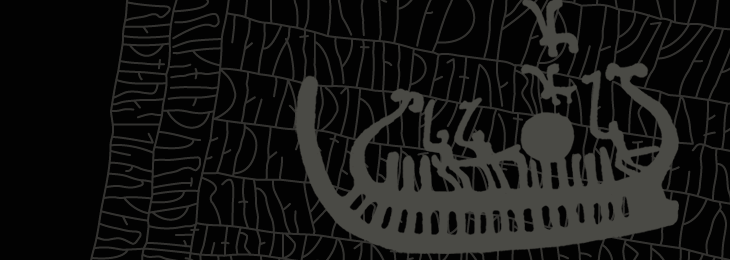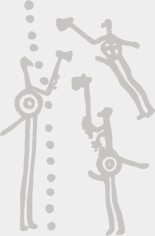A Special Note about Meter and Performance
By Benjamin Bagby
This text is an appendix to the Beowulf program notes when Bagby's performance is given for an audience of medievalists and Anglo-Saxonists. In it, he speaks to some of the most important scholarly issues of reconstructing the ancient text as performance.
The metrical genius and sophistication of alliterative poetry is apparent to anyone who has come into contact with works such as Beowulf, yet, as a performer, the issue which interests me is this: how would such metrical structures have expressed themselves in performance, in a culture which hardly knew reading and writing, and which certainly did not know musical notational systems? Our relationship to Beowulf is based on a ‘literate’ course of study: readings, analyses and exercises, using textbooks, editions, translations and manuscript facsimiles. There is no one alive today who has learned this poetic art as a uniquely oral phenomenon. As literate beings, we are fascinated by various metrical structures and functions which can be indicated in writing, with markings which can show us the carefully-graded varieties of ‘beats’, ‘accents’ and ‘secondary stresses’; we take a positivistic delight in expressing metrics by means of musical notation, with its precise – yet unforgiving – font of symbols; we have heard our teachers recite the poems in clearly-defined metrical patterns (perhaps with a bit of tapping on the desk for emphasis), and this has become, for us, the ‘sound’ of Old English alliterative poetry.
Like most music students, I was programmed at an early age with a great reverance for notation, metrics and the unassailable authority of ‘the score,’ but a subsequent lifelong involvement with medieval European song has provided me with some more pliable, more differentiated tools for the shaping of texts and melodies, for the telling of stories. When I approached Beowulf for the first time, with the intention of reconstructing a performance, I listened to all of the available recordings of experts reading the original text. I was struck by what I perceived as an exaggerated emphasis on the pure mechanics of metrics: the metrical patterns of various lines, which for an oral ‘singer of tales’ would normally function on a deeper structural level, had broken the surface of the text (and the story), becoming obvious and heavy in the mouth of the reciter, and intrusive in the ear of the listener. The musician (and story-teller) in me imagined a subtler role for these delightfully vivid and supple metrical patterns, and I resolved to work on the text of Beowulf (and later, the Edda) in such a way that the metrical structures are servants of the performance and not its master. Through long hours of practical work, I searched for ways to give the metrics a powerful yet less superficial function in support of the the text, so that the story would be free to emerge as an aural experience, held together from within by an almost imperceptible array of interlocking sounds and impulses.
In trying to explain this, we might consider an analogy to dance: the dancer spends long years in a training routine which is designed to refine and strengthen a disciplined ability to move the body expressively. This training is intensely involved with the rather mechanical work of structural body parts (muscles, tendons, bones, etc.) moving in space and time, and the dancer is acutely aware of these structures, how they move, and where they are placed in relation to one another. In the dance studio, they are the focus of the work, the heart of the matter. However, this structural work will ultimately be put in the service of some kind of story, and at the moment when the dancer begins to work with a choreographer there is a gradual shift of focus. Later, as audience members watching the resulting choreography, we non-dancers would not be principally absorbed with the locomotion of muscles, bones, and tendons in space and time, but rather with the expressive qualities of the choreography (of course, we must allow for the possibility of a choreography which has locomotion as its subject). The illusion which dancers can create, their effortlessness and beauty of movement, depends utterly on powerful structures and functions within the body itself, and yet it is the body which also masks them, so that the dance itself remains in the foreground of perception. The audience has come to experience a story, to enter into a narrative embodied by the dance, and not to be confronted with the structures, processes and techniques which are used to make the telling effective.
As a performer of metrically-structured texts, I do not have the role of teaching metrical theory to my listeners, but of telling a story; and yet, this does not mean that the metrical structures are beging neglected. On a very deep level I do experience the metrics as I sing and speak the story; they are influencing and shaping my use of voice, instrumental accompaniment, timing, speed and rhetorical gesture, in short, all of the variables of performance. Assuming a small medieval audience of cognoscenti who had heard a given story already dozens – if not hundreds – of times, there would be among the listeners a subtle appreciation of the text’s inner structures, even a certain delight in the singer’s masking of the obvious, and in the performance’s interplay of sounds, patterns, and meaning. I work to create a metrically-aware performance Beowulf, based on a written source, but aiming to re-create the spirit of an oral poem performed in a notationless culture. My goal is to allow the metrical structures their important place in the text, but that they should function subtly, creatively, almost subconsciously. All elements of measured time must be free to help shape the story: from the smallest unit of the individual syllable to the single, long pulse of an entire performance.


